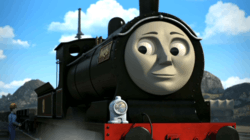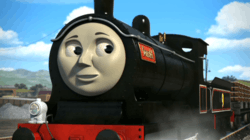Donald and Douglas
| Donald and Douglas | |
|---|---|
| Thomas & Friends character | |
|
 | |
| First appearance |
The Twin Engines (Thomas & Friends) |
| Voiced by |
Rob Rackstraw (UK/US; 2016-present; S20 onwards; Donald) Joe Mills (UK/US; 2015-present; Sodor's Legend of the Lost Tresure onwards; Douglas/2015-2016; Sodor's Legend of the Lost Tresure and The Great Race; Donald) Yūki Satō (Japan; 1990-2003; S2-7: Donald/Thomas Comes to Breakfast and Thomas and the Special Letter only: Douglas) Takeshi Endo (Japan; S2-7; 1990-2003: Douglas) Kyousei Tsukui (Japan; 2007-present; S11 onwards) |
| Numbers | 9 and 10 |
| Information | |
| Gender | Males |
Donald and Douglas are two fictional steam locomotives from The Railway Series books by the Rev. W. Awdry. They also appear in Thomas & Friends, the television series based on the books. They are twin Scottish engines.
Introduction

The Fat Controller originally only ordered one engine from Scotland, but was surprised when two engines arrived, neither with numbers or any distinguishing features – both engines were painted completely black. He could not tell which engine was which, and so decided to keep whichever one was the more useful. Unfortunately, Douglas accidentally shunted Thomas' Special Coach, full of Passengers, into a siding at Tidmouth, thus infuriating the Passengers. Things worsened when Donald managed to demolish a signal box. Douglas, meanwhile, made the decision harder by helping James up a hill, succeeding in spite of James losing steam, but destroying a spiteful brake van in the process.
However, the twins proved their worth to the railway in winter, when their experience and expertise with snow made them excellent snowplough engines. The other engines appealed to the Fat Controller in "The Deputation" and he decided to keep both of them. In the Railway Series, they were painted blue shortly afterwards and given nameplates.
The twins are almost identical, and some episodes of the television series have depicted them as being inseparable (notably the episode "Twin Trouble"). The reason for their both arriving on Sodor was that Donald was bought and saved from scrap, but Douglas was not and was due to be cut up (this fact is revealed in the story "The Missing Coach"). They could not bear the thought of one being saved and the other not so they decided to go to Sodor together and hope for the best. As their crews were also related, it was not difficult for them both to stay on the island. To allow the engines to be told apart, the Fat Controller ordered that numbers be painted on their tenders. Following an incident in which the engines swapped tenders, he decided that it would also be wise to give them nameplates on their boilers as well.
Donald and Douglas are popular among the other engines, not only for their versatility but also their practical and friendly demeanour. They enjoy a good joke, as exemplified when Duck's driver slipped a duck into Donald's tank, resulting in Donald gaining a new friend in Dilly the duck. They put their all into any job, no matter how difficult. And, because of their own brush with scrapping, they have the utmost sympathy for engines escaping the scrapyard. It was this sympathy that made Douglas a hero, when he rescued Oliver and Toad (and an autocoach named Isabel in the books) from scrap and brought them to Sodor. In the Railway Series, Toad became his brake van following this incident.
The Twins are mainly used for goods work, but can be used for all sorts of jobs all over the railway. They are very much the "odd job engines" of the line. They carry out track repair, collect engines from the Works, rescue engines that have broken down or crashed and, of course, clear snow in the winter. The railway would not be the same without them. They are, in the Fat Controller's words, "Really Useful Engines".
They first appeared in the book The Twin Engines, published in 1960. Their first appearance in the television series was in Season 2. They appeared at regular intervals until Season 7, then were not seen again until Season 11 episode "Gordon and the Engineer", although they did get a mention in the Season 8 episode "You Can Do It, Toby!" and also appeared in a deleted scene in Season 8's "Edward the Great". They also played a prominent role in Season 12's "Saved You!". They returned to the series in Sodor's Legend of the Lost Treasure, where they played a supporting lead role and were both voiced by Joe Mills in both the UK and US versions.
From Series 20 onward, Donald is voiced by Rob Rackstraw, whilst Douglas is voiced by Joe Mills, respectively.
Scottish engines
Donald and Douglas are unusual among characters in the Railway Series, in that they speak in a strong Scots dialect. This can be difficult to understand at times (and indeed, the Rev. W. Awdry received a number of letters complaining of this very problem). This is exemplified in their excuse for not carrying numbers: "They must have slyly slipped off, sir".
Their accent has been identified by a number of readers as originating in Glasgow, although the writer Martin Clutterbuck notes a strong Robert Burns influence.
The engines' Scottish heritage has been referenced in a number of stories. In the book Stepney the "Bluebell" Engine, Douglas mentions the song 'The Bluebells of Scotland'. [1] While in Jock the New Engine, Douglas regards the unnamed engine's unusual colour (undercoat): "Some o' the engines up in the Highlands were yon [that] colour. Jocks, we used to call them." He goes on to suggest that "Jock" might be a good choice, and so the title character gets his typically Scottish name, and is painted in the distinctive pale green livery of the Highland Railway. [2]
In The Railway Series and in My Thomas Story Library, Donald and Douglas were painted NWR blue when Sir Topham Hatt (the Fat Controller) decided to keep them that color; however, in the television series they remained black instead of being changed to blue.
Prototype
Donald and Douglas are both based on the Caledonian Railway 812 Class. In The Railway Series, it is stated that one of them is number 57646 (though it is only revealed to the reader that this is in fact Donald, when Douglas has the alarming thought "I hope the Fat Controller disnae realise I shouldna be here") . None of the original 812 class carried this number — the joke being that in real life, the highest numbered was 57645.
The blue they carry in the Railway Series is significant, as blue was the colour most associated with the Caledonian Railway. In the book James and the Diesel Engines, Donald explains that while on the Caledonian Railway they were never painted blue, they always carried the black goods livery. Interestingly, the black that they used to carry (and indeed still do in the television series) is British Railways black with red and white lining, making them the only engines to carry a BR livery.
The engines have deep-toned whistles, which Gordon and Henry observed made them sound like buses or ships. Although unusual on Sodor, such whistles were typical of the Caledonian Railway and LMS.
One Caledonian '812' class survived into preservation: 828 is currently based on the Strathspey Railway, Aviemore, Scotland and is currently in service after a long overhaul.
Douglas on the Mid Hants Railway
In 2000, the Mid Hants Railway in Hampshire converted a Hunslet Austerity 0-6-0ST class engine into a tender engine remeniscient of the London and South Western 700 class 0-6-0 tender engines, a move which was greeted by a negative reaction from railway enthusiasts as it was not a true replica but a 'look-a-like'. This rebuilt locomotive poses as Douglas for special events.
Merchandising
| Model range | Type |
|---|---|
| Ertl | die-cast metal |
| Take Along/Take n Play | die-cast metal |
| Thomas & Friends Wooden Railway | wood |
| TrackMaster | plastic motorized |
| Bachmann Trains | HO gauge plastic models |
References
- ↑ Awdry, Rev. W. (1963). Stepney the "Bluebell" Engine. Edmund Ward. p. 4. ISBN 0-7182-0017-9.
- ↑ Awdry, Christoper (1990). Jock the New Engine. Heinemann. pp. 44–5. ISBN 0-434-97611-3.
